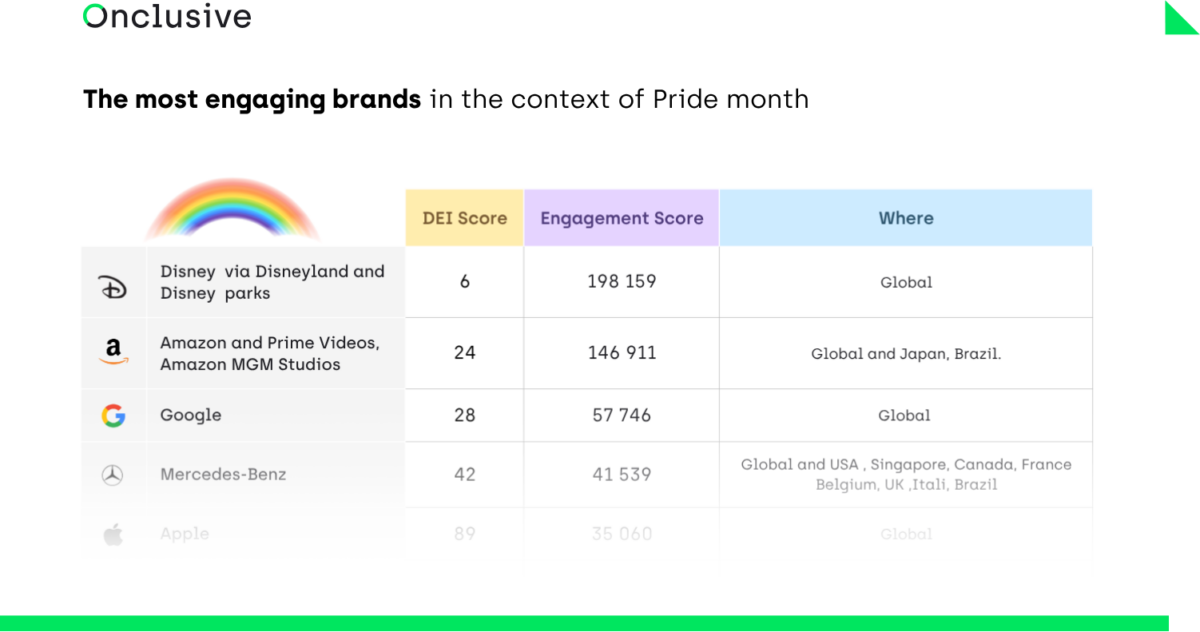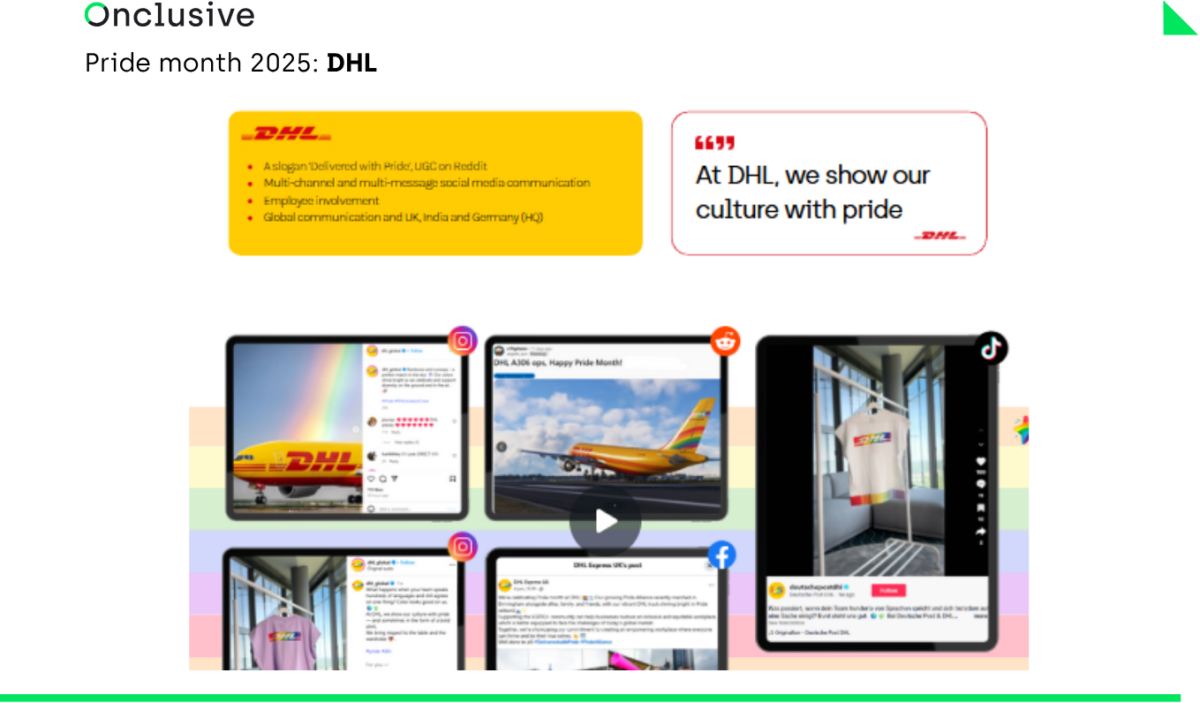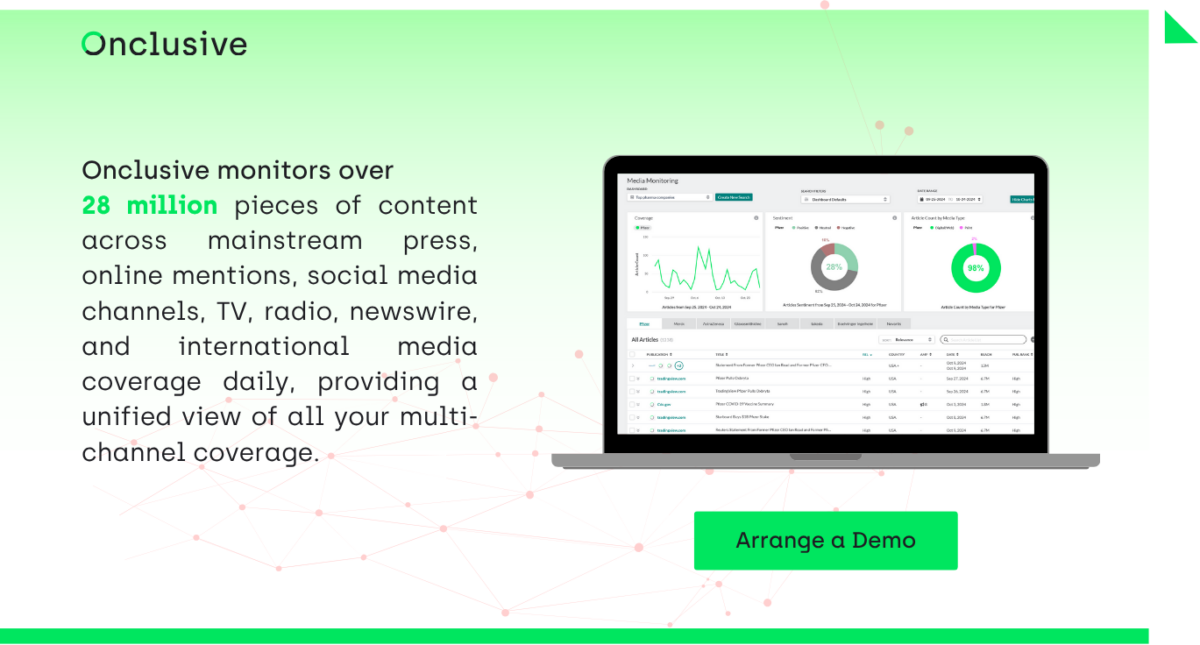The Pride Month 2025 media ecosystem reveals major structural transformation, amplified by political changes following Donald Trump’s inauguration in January 2025. Onclusive’s comprehensive analysis spanning May 1 – June 20, integrating 7.8 million social mentions and 104,050 traditional media mentions, exposes corporate DEI strategy adaptation mechanisms within a reconfigured regulatory environment.
Pride Month has long been a pivotal moment for brands to spotlight their commitment to Diversity, Equity, and Inclusion (DEI), particularly in support of the LGBTQ+ community. However, as the socio-political climate grows increasingly complex, brands face heightened scrutiny and challenges in authentically communicating their values. Onclusive’s Pride Month 2025 Pulse report offers a revealing look at how major brands approached this year’s Pride Month, analyzing their presence across mainstream and social media during the first two weeks of June. The data paints a picture of caution, adaptation, and, in some cases, bold engagement.
In this article, we’ll dive into the report’s findings, explore the evolving strategies of top brands, and place these insights within the broader context of current events and DEI trends. Onclusive’s media intelligence approach relies on integrated technological architecture combining specialized tools for social media and traditional media analysis. This linguistic coverage spans English, Spanish, Portuguese, Italian, and German, enabling comprehensive semantic capture of corporate communications within volatile political contexts.
Pride: A Significant Shift in Brand Communication
The 2024-2025 comparative analysis reveals contradictory dynamics particularly illuminating for communication professionals. Social media demonstrates a 21.5% increase in global mentions rising from 6.50 million to 7.9 million, yet reach decreased by 14.4% from 165.3 million to 141.5 million. This paradox illustrates how increased conversation volume can accompany reduced influence and degraded sentiment for corporate initiatives. The fact that many influential brands have scaled back their communications is one of the reasons for the drop in overall Reach.
Traditional media sentiment maintains 65% positivity while brand-specific sentiment drops to 53%, revealing critical polarization patterns.
The report also highlights a shift in the nature of brand communication. In 2024, many brands created dedicated Pride pages on their websites and posted extensively on social media. This year, such initiatives were rare, with many brands opting for minimal or no global communication. Social media activity saw a sharp decrease, and mentions of Pride marches were largely absent from official brand accounts, surfacing instead through employee-driven content.
This retreat from Pride-specific messaging is further reflected in the media narratives surrounding brands. Onclusive identifies three main themes: scrutiny, internal-only, and a decline in sponsorships. These narratives indicate that brands are under more pressure than ever, leading many to reevaluate their approach to Pride Month activations.
Top Brands by Engagement: A Tale of Discretion and Impact
Despite the overall decline in communication, some brands managed to generate significant engagement during Pride Month 2025. The report ranks the top 10 brands by engagement score, which includes social media interactions, press coverage, and sponsorship news. Notably, Disney topped the list with an engagement score of 198,159, despite having a relatively low DEI score of 6 in Onclusive’s Brand Influence Rank.
Disney’s communication was notably discreet, primarily channeled through its parks (e.g., Disneyland) and messages from park executives rather than the corporate entity itself. This subtlety is telling: in February 2025, Disney reportedly backed away from DEI initiatives to refocus on its core entertainment mission, according to an internal memo. Yet, despite this shift, Disney’s Pride-related content still resonated widely, suggesting that even toned-down messaging can be effective when aligned with a brand’s broader identity.
Other top performers included:
- Amazon (Engagement Score: 146,911), which leaned into its Glamazon initiative—an LGBTQ+ employee resource group—particularly in Japan, where it partnered with actor and YouTuber Dai Nakai. Amazon also promoted LGBTQ+ content through Prime Video and Amazon MGM Studios.
- Google (Engagement Score: 57,746), which maintained a global presence, though with less fanfare than in previous years.
- Mercedes-Benz (Engagement Score: 41,539), demonstrates a remarkable contrarian initiative, maintaining US communication across LinkedIn, TikTok, and Instagram while competitors retreat. Their exclusive visual creations by artist Andhika Ramadhian support “We celebrate every road you take” messaging across coordinated multi-country deployment, making them one of the only major brands maintaining active US presence during Pride Month 2025.
These brands’ success in generating engagement, even amid a broader pullback, highlights the importance of authenticity and consistency in DEI messaging.

The most engaging brands in the context of Pride month. Excerpts (Source: Onclusive- Pride Month 2025 Pulse)
Messaging Themes: From Celebration to Caution
The report also sheds light on the key themes and topics brands emphasized in their Pride Month communications. The most prominent message, accounting for 17.55% of brand content, was “Standing up for equity, inclusivity, and being an ally to the LGBTQ+ community.” Other recurring themes included:
- “Better outcomes for customers with diverse thinking and inclusion” (9.51%)
- “Celebrate LGBTQ+ communities around the world” (9.37%)
- “Celebrate individuality, allyship, and inclusion” (8.29%)
While these messages align with Pride’s spirit, they also reflect a broader, safer approach to DEI. Unlike the celebratory, Pride-specific campaigns of previous years, many brands in 2025 opted for language that could apply to any marginalized group. This shift suggests a cautious strategy, likely influenced by the tense political climate.
Some brands also focused on internal initiatives rather than public-facing campaigns. For example, PwC highlighted its Global Shine Summit, where employees from around the world gathered to celebrate Pride, and its participation in Pride marches in cities like Helsinki and Berlin. This emphasis on employee-driven content and internal culture may be a way for brands to demonstrate commitment without courting external controversy.

Pride month 2025: Key Messaging Themes and Topics from Brands (Source: Onclusive- Pride Month 2025 Pulse)
Brand Spotlights: Navigating Complexity with Creativity
Despite the overall trend toward discretion, a few brands stood out for their creative and impactful Pride Month campaigns:
- DHL: With the slogan “Delivered with Pride,” DHL embraced a multi-channel approach, including user-generated content on Reddit and employee involvement. Its communication spanned global and local accounts, particularly in the UK, India, and Germany.
- Mercedes-Benz: The automaker’s campaign, “We celebrate every road you take,” featured visuals by artist Andhika Ramadhian and was shared across LinkedIn, Instagram, TikTok, and Facebook in multiple countries. This consistent, visually driven messaging helped Mercedes-Benz cut through the noise.
- PwC: Under the banner “Together, we shine,” PwC highlighted its internal LGBTQ+ inclusion network, Shine, and its Global LGBT+ Inclusion Strategy. The brand also promoted its participation in Pride marches, positioning itself as a leader in fostering an inclusive workplace.
- Apple: As one of the first major brands to communicate about Pride Month in 2025, Apple introduced its Pride Collection in early May. Despite the politically charged environment—referenced in media headlines like “Despite Trump: Apple continues to wave the Pride flag”—Apple’s communication was relatively sober but still went viral, demonstrating the brand’s ability to engage audiences even in fraught times.
These examples illustrate that while many brands dialed back their Pride efforts, others found ways to authentically engage with the moment, often by focusing on employee stories, inclusive workplace initiatives, or creative partnerships.

DHL: a multi-channel approach, including user-generated content on Reddit and employee involvement. (Source: Onclusive- Pride Month 2025 Pulse)
The Broader Context: DEI in a Polarized World
The shift from 2024 to 2025 represents the culmination of mounting pressures that began with the 2023 Bud Light and Target controversies. When Bud Light partnered with transgender influencer Dylan Mulvaney in April 2023, the resulting backlash cost Anheuser-Busch an estimated $1.4 billion and its position as America’s #1 beer brand after 20 years. Target faced similar consequences when threats against employees forced the retailer to move Pride merchandise to the back of stores, causing a 5% drop in quarterly sales.
The Trump administration’s January 2025 executive orders “Ending Radical and Wasteful Government DEI Programs” and “Ending Illegal Discrimination and Restoring Merit-Based Opportunity” escalated federal pressure dramatically. 61% of companies cited Trump administration pressure as the primary reason for their Pride pullback (*), with the Department of Justice directed to investigate “egregious and discriminatory” private sector DEI programs and the EEOC ordered to pursue lawsuits against corporate diversity initiatives. Companies with federal contracts faced particular scrutiny under False Claims Act threats.
The legislative environment has become increasingly hostile, with 923 anti-LGBTQ+ bills under consideration across 49 states in 2025, up from 508 in 2023. This surge in legislative attacks, combined with organized conservative activism led by figures like Robby Starbuck who successfully pressured Walmart, Lowe’s, Ford, and Toyota to dismantle DEI programs, created an environment where Pride support became a liability rather than an asset. The rise of anti-ESG investment movements, with U.S. ESG funds experiencing net outflows of over $13 billion in the first half of 2024, further pressured companies to abandon visible social activism. (**)
Analysis reveals tangible economic consequences of these strategic mutations. NYC Pride faces an estimated $750,000 deficit after 25% corporate support cancellation or reduction, illustrating financial materialization of reputational issues. This contraction pushes organizers toward alternative financing models, notably community crowdfunding, signaling possible sustainable decentralization of LGBTQ+ initiative support.
The decline in Pride Month communication must be understood within the broader socio-political context. In recent years, brands have faced increasing pressure from both sides of the political spectrum. Progressive consumers demand authentic DEI commitments, while conservative groups have pushed back against what they perceive as “woke capitalism.” This tension has made Pride Month a potential minefield for brands, leading many to adopt a more cautious approach.
Disney’s internal memo, mentioned in the report, is emblematic of this shift. By refocusing on its “core entertainment business mission,” Disney signaled a retreat from overt DEI initiatives—a move likely influenced by external pressures. Similarly, the report notes that Apple’s Pride communication occurred “despite the tense political environment,” underscoring the challenges brands face in balancing their values with public perception.
Yet, as the Onclusive data shows, brands that can authentically demonstrate their commitment to DEI—through actions, not just words—still have the potential to resonate with audiences. DHL’s employee-driven content, Mercedes-Benz’s global visual campaign, and PwC’s internal summit all exemplify ways to engage meaningfully without overstepping into performative territory.
Conclusion: Authenticity is Key
The predominance of generic diversity language over specific LGBTQ+ celebration, the virtual disappearance of Pride parade sponsorships in big cities, and the retreat to internal-only initiatives collectively signal the end of Pride Month as a major corporate marketing moment. Yet the persistence of internal support and the companies maintaining visible advocacy suggest that corporate LGBTQ+ inclusion may be evolving rather than ending, moving from performative marketing to operational integration.
As the socio-political climate continues to evolve, brands will need to strike a delicate balance—honoring their DEI commitments while avoiding the pitfalls of perceived inauthenticity or opportunism. The Onclusive report offers a valuable snapshot of this moment in time, and it will be fascinating to see how brand strategies adapt in the years to come.
(*) Pride Month 2025: Survey Insights on Engagement, Stakeholders, and Strategy https://www.gravityresearch.com/posts/corporate-approaches-to-pride-2025/
(**) https://amac.us/newsline/society/why-pride-month-2025-is-falling-flat/ https://www.abc.net.au/news/2024-06-30/record-anti-lgbtqia-bills-loom-over-pride-in-the-us/103999742

